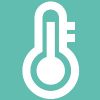Ventilation systems (CMV or AHU) present in a building ensure the renewal of indoor air. These systems guarantee the protection of the premises against damage caused by humidity and mold. They thus keep buildings healthy and protect occupants from the consequences of indoor air pollution. That is why it is crucial to regularly renew indoor air. The proper functioning of ventilation systems is therefore essential.
State of the art
of dwellings (often pre-1974) do not have ventilation systems
0 %
Indoor air is 5 to 10x more polluted than outdoor air
0
56% of dwellings have airflows below regulatory requirements
0 %
Health effects
An efficient ventilation system allows the evacuation of CO2, fumes, dust, mites and limits the development of mold or humidity. The maintenance and controlled management of ventilation systems also reduces energy consumption and improves the thermal comfort of the building.
It has been proven that poor indoor air quality can generate olfactory discomfort, drowsiness or eye and skin irritations, but also more acute or chronic pathologies such as asthma, respiratory allergies, cancer or poisoning that can be fatal.
We then quickly understand the challenges of good air renewal in our homes, offices and enclosed living spaces.
Effects on the building
Clean air reduces health risks and also preserves the building. A malfunctioning ventilation system causes significant damage to the building and also considerable repair costs. Risks associated with poor ventilation of the building:
- Degradation of the frame, with the appearance of:
o fungi on the wood (beams, floors, frames) and furniture,- mist, see water run-off on windows and walls.
- a white deposit at the foot of the walls inside the dwelling.
- blackish stains that invade fabrics and walls and are accompanied by an unpleasant smell.
- Fire hazards: Poor air circulation causes grease to accumulate in the ducts. The motor then becomes noisier until the fat material causes a short circuit.
- In the event of a fire, with a CMV that works:
- allows the limitation of smoke transmission to the dwellings via ducts network,
- participates in the evacuation of smoke in the dwelling.
Action levers
To improve the level of indoor air quality, there are several levers for action:

Regular maintenance of ventilation systems

Early detection of malfunctions in the ventilation system

Daily room ventilation

Indoor temperature and humidity control

Monitoring for the appearance of mould stains
Focus on ventilation systems
There are currently different types of ventilation systems, each with its own particularities.
In a building composed of dwellings there are generally two types of equipment: either a gas CMV or a conventional CMV.
A gas CMV that breaks down causes the boiler to shutdown immediatly, which results in a cut-off of the hot water supply and potentially of the heating system. The shutdown of this type of ventilation system is very constraining but easily and quickly detectable. In contrast to a failure on a conventional VMC, which is independent of the boiler, for which the external effects of the shutdown or bad system are difficult to perceive. It is often when the first moulds appear that the failure is noticed.
In order to ensure the proper functioning of this equipment, professionals in the sector act on two aspects:
- Corrective maintenance: troubleshooting as quickly as possible in the event of a reported malfunction.
- Preventive maintenance: checking the system’s condition on a regular and scheduled basis, regardless of its state, whether or not travel is necessary.
Another solution exists alongside these two types of intervention: the implementation of a monitoring system to intervene before any failures.
Such a solution makes it possible to anticipate the malfunctioning of the VMC/CTA or at least to act as quickly as possible when it occurs. It avoids unnecessary travel by technical teams. Maintenance companies thus gain in efficiency and improve the quality of life of users.
IoT devices such as the adeunis Delta P sensor monitor the ventilation boxes and anticipate possible malfunctions. Thus the professionals of the sector can :
- detect a pressure delta between the box and the atmospheric pressure over time,
- anticipate an engine failure,
- identify a repetitive malfunction.
On curative aspects, an alert is issued when a :
- engine stops working,
- filter is clogged,
- belt operation problem appears (the engine continues to run but the air is no longer being exhausted),
- pressure switch is faulty.
Benefits of using ventilation system monitoring equipment

Reduce maintenance costs

Improve responsiveness

Ensuring occupant comfort
20/06/2020







